RARE! WWII 1943 U.S. 5th Air Force Caroline Islands "South West Pacific Area Command" Combat Flight Navigation Map
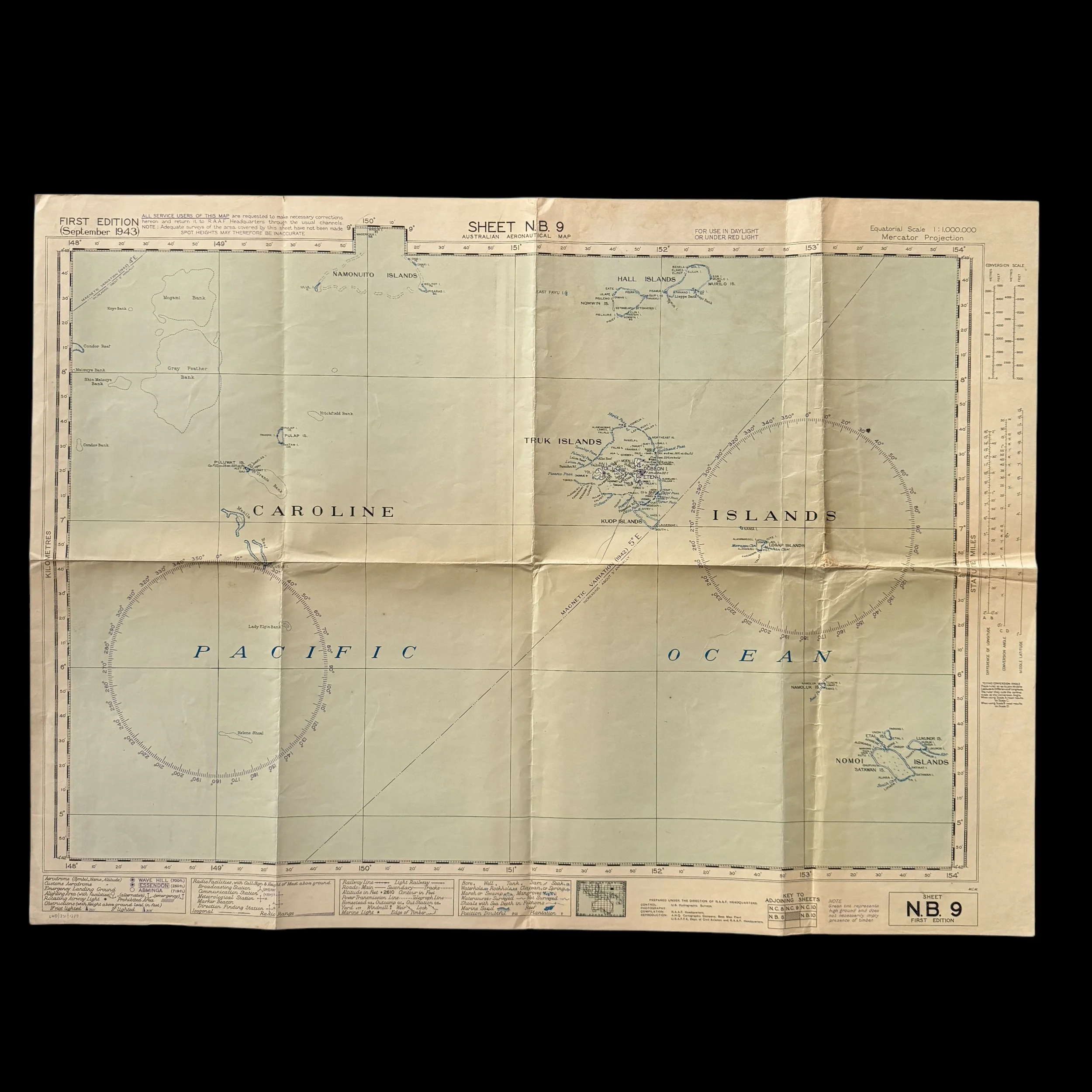
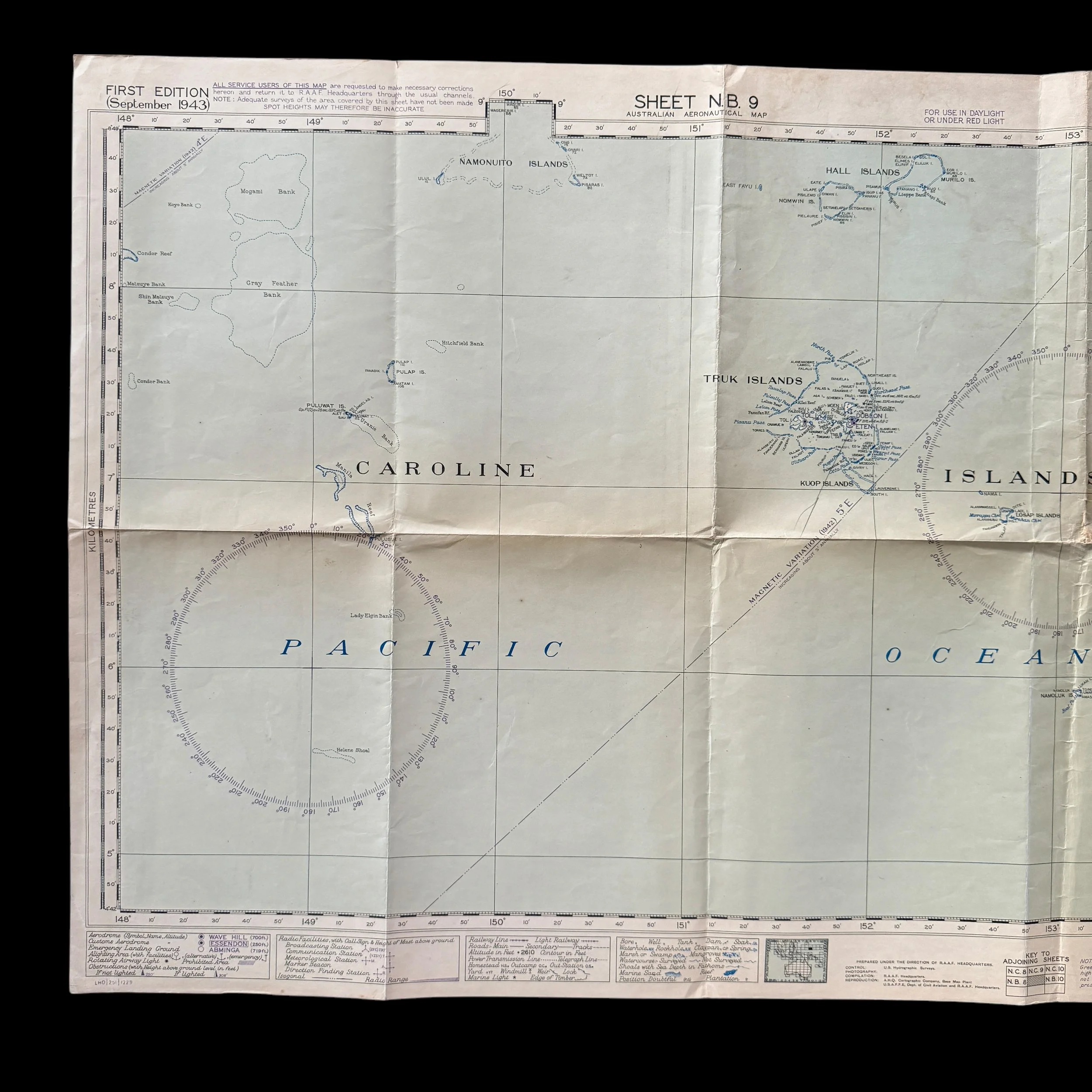
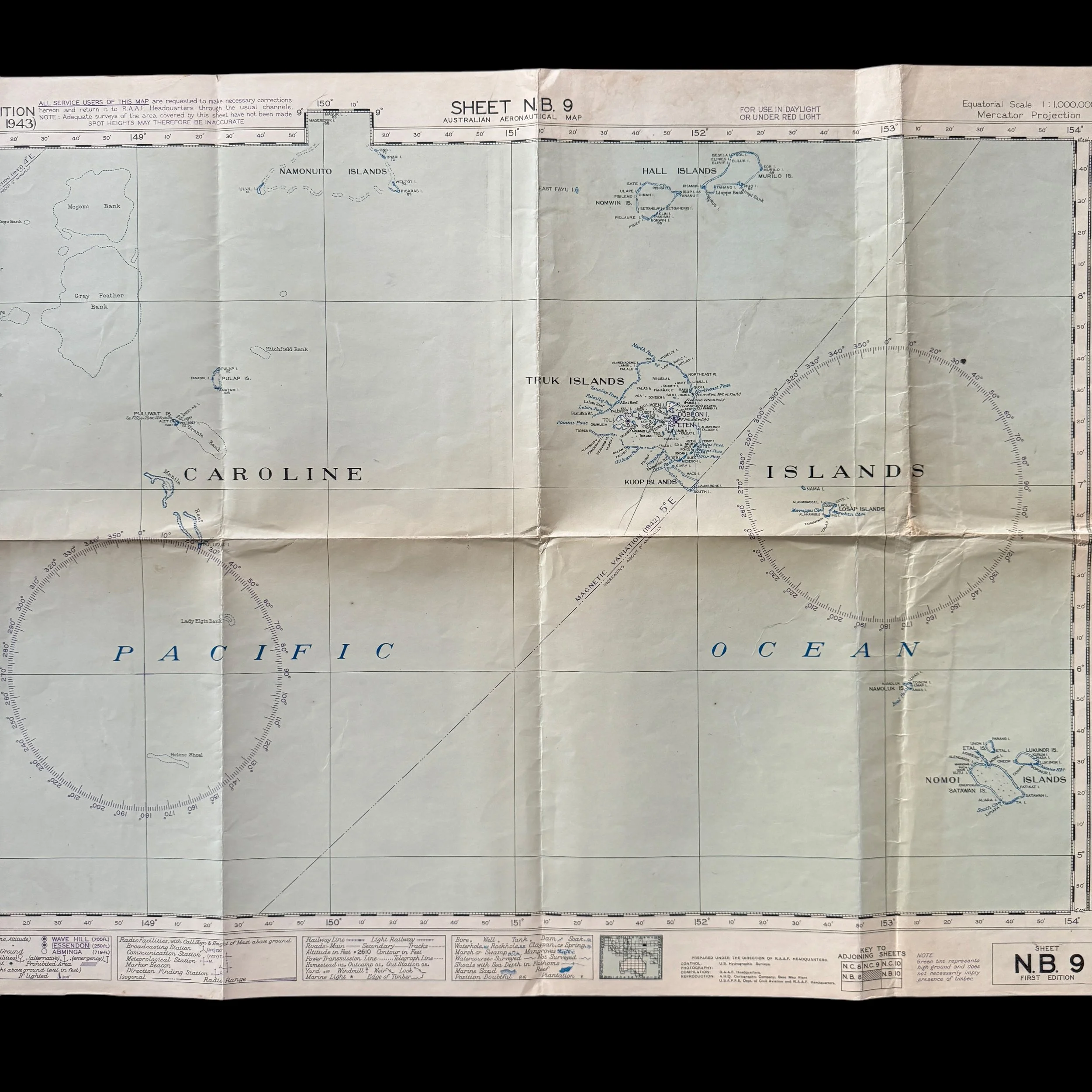
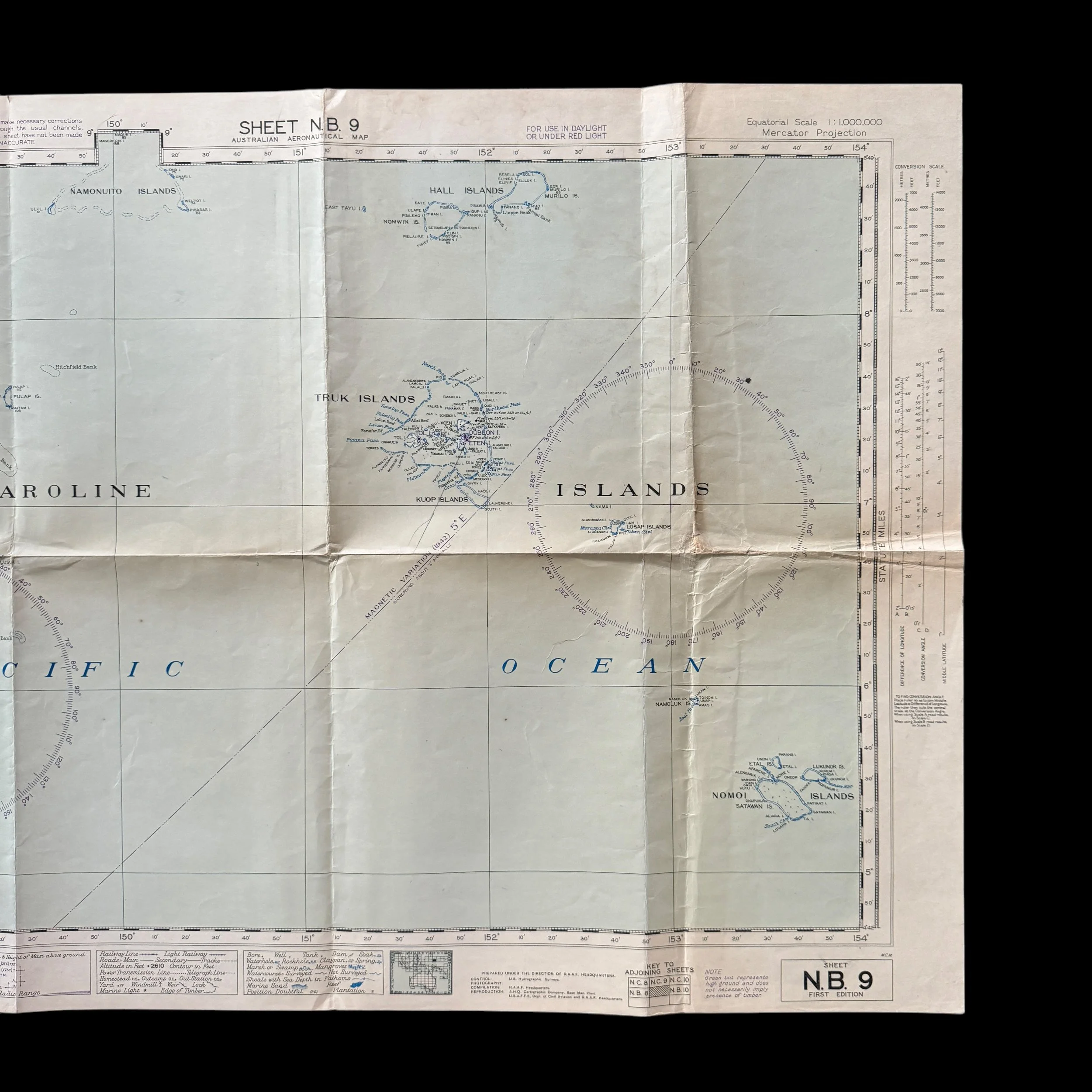

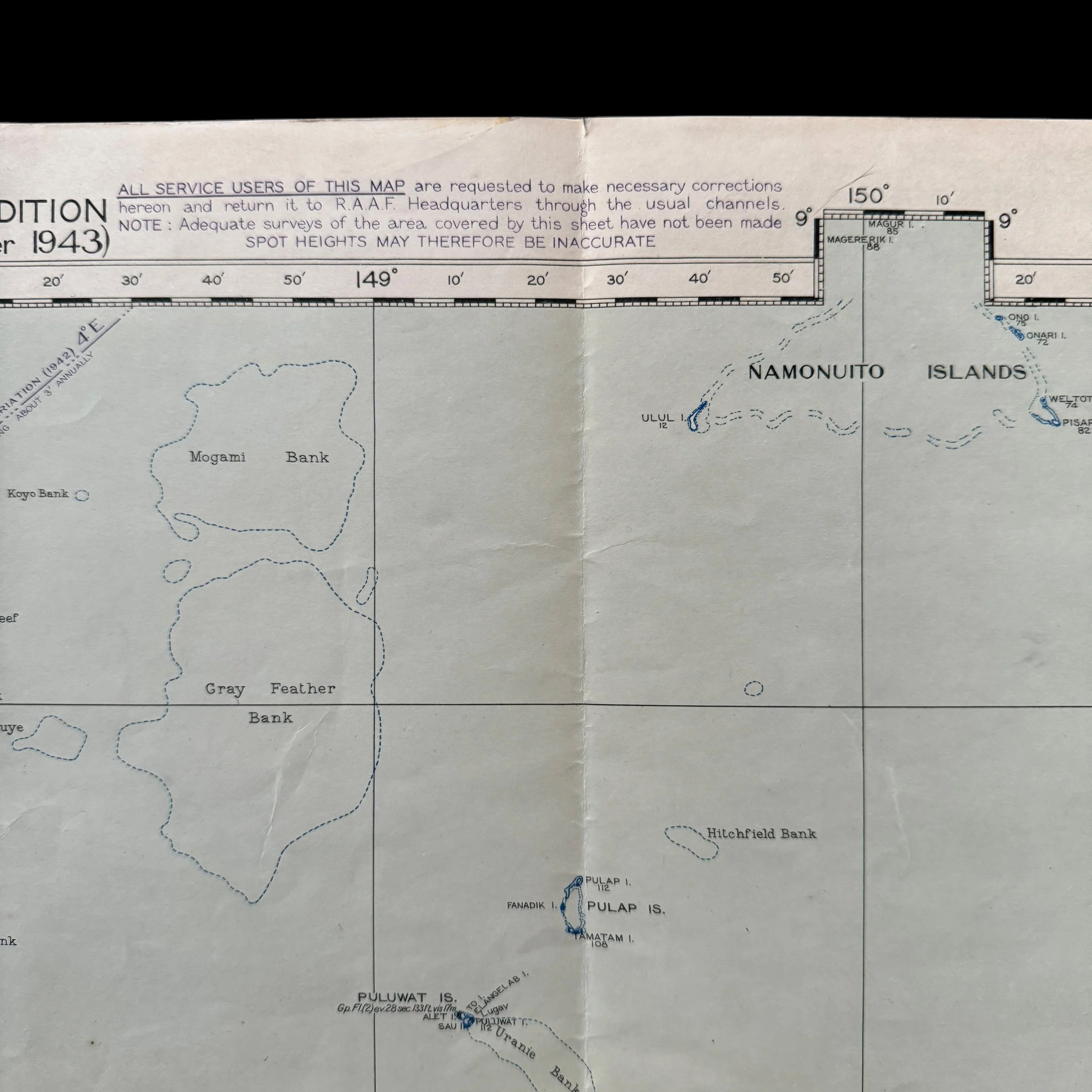
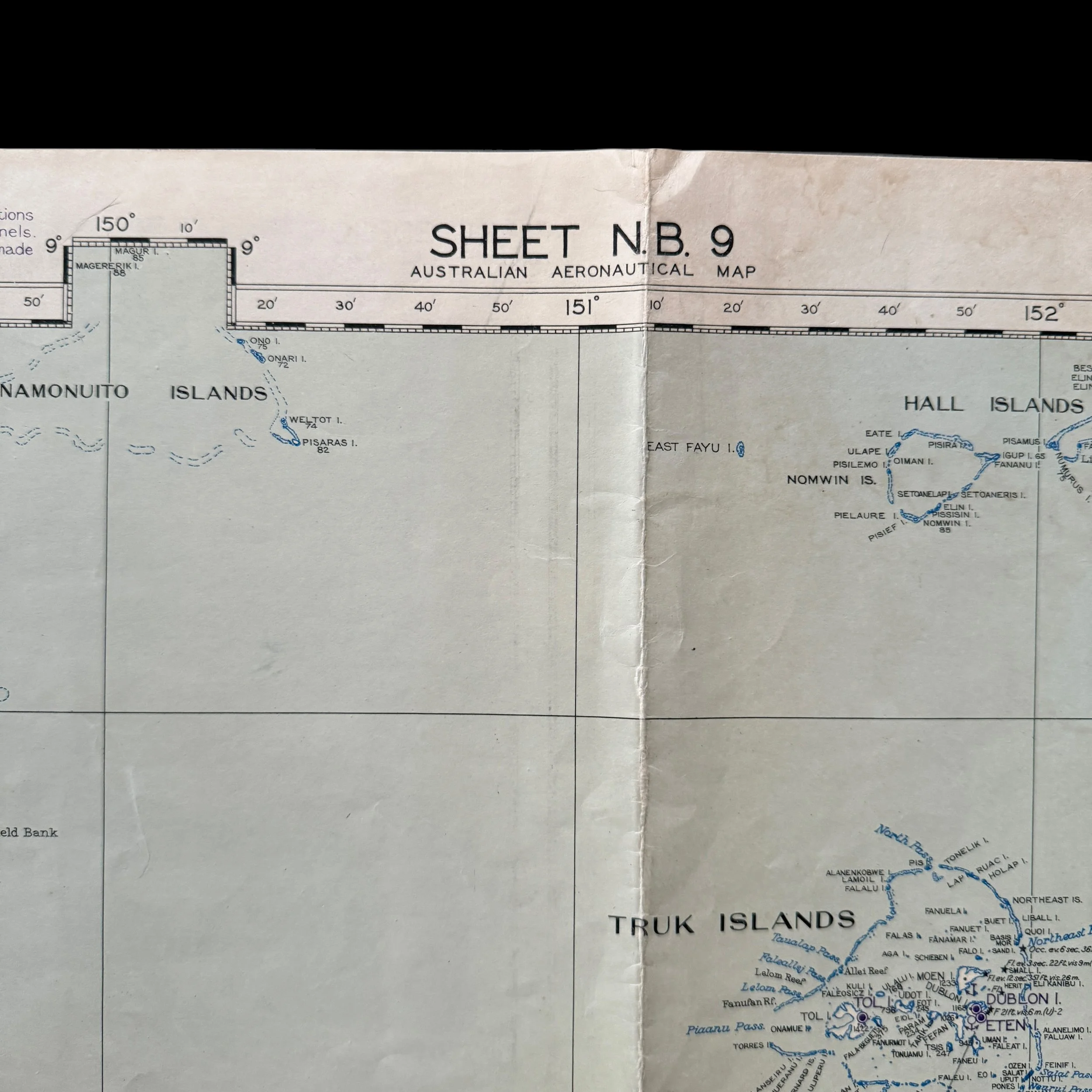

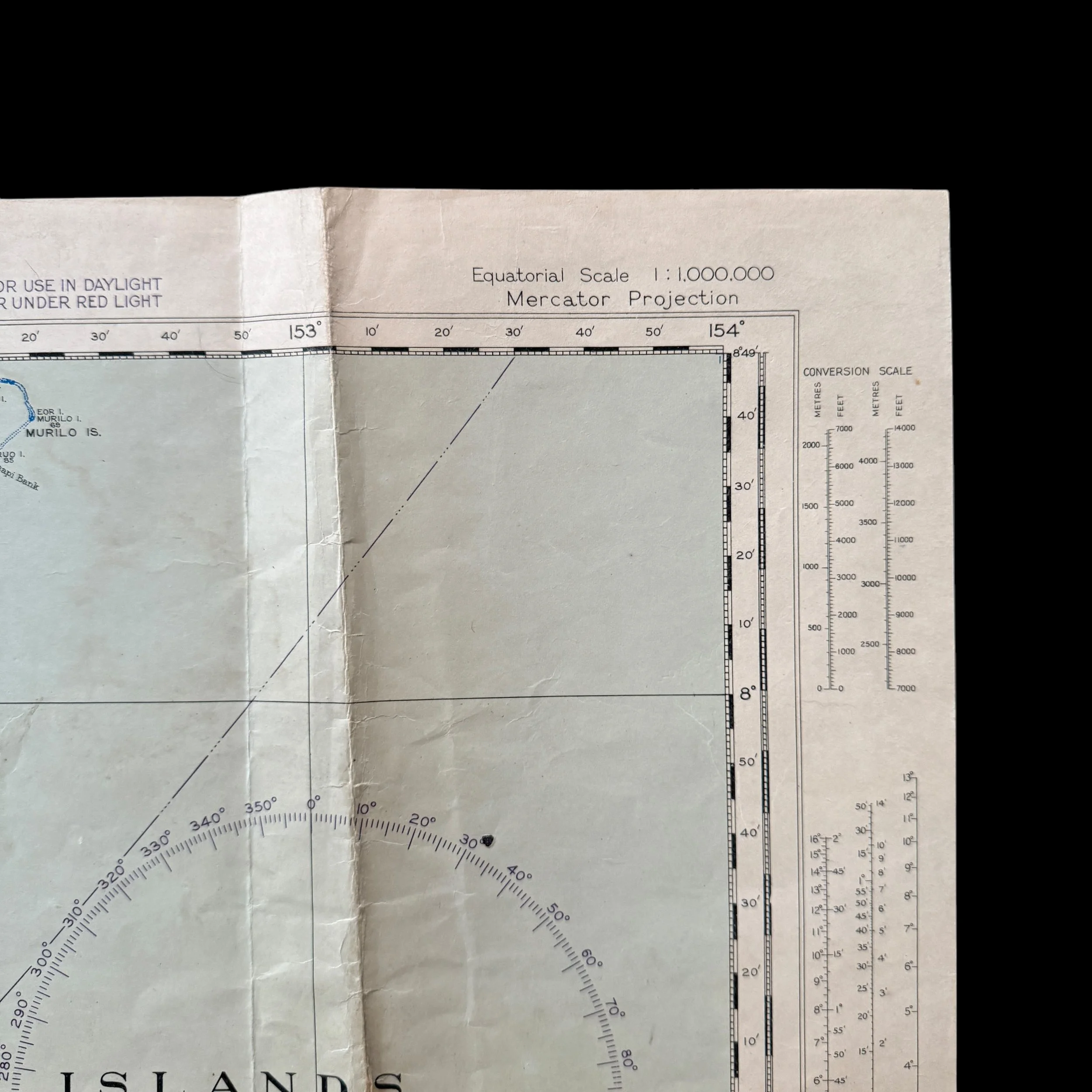
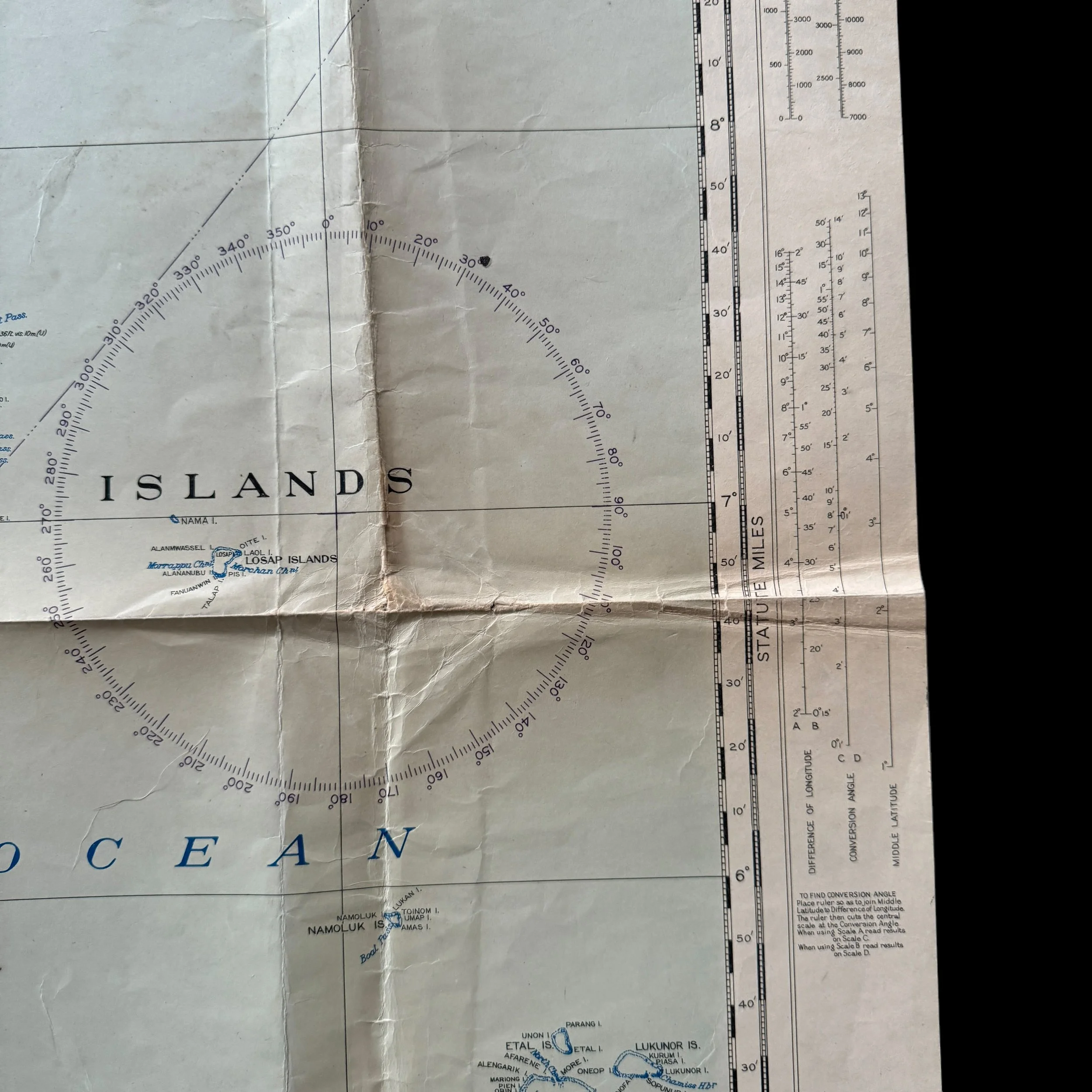
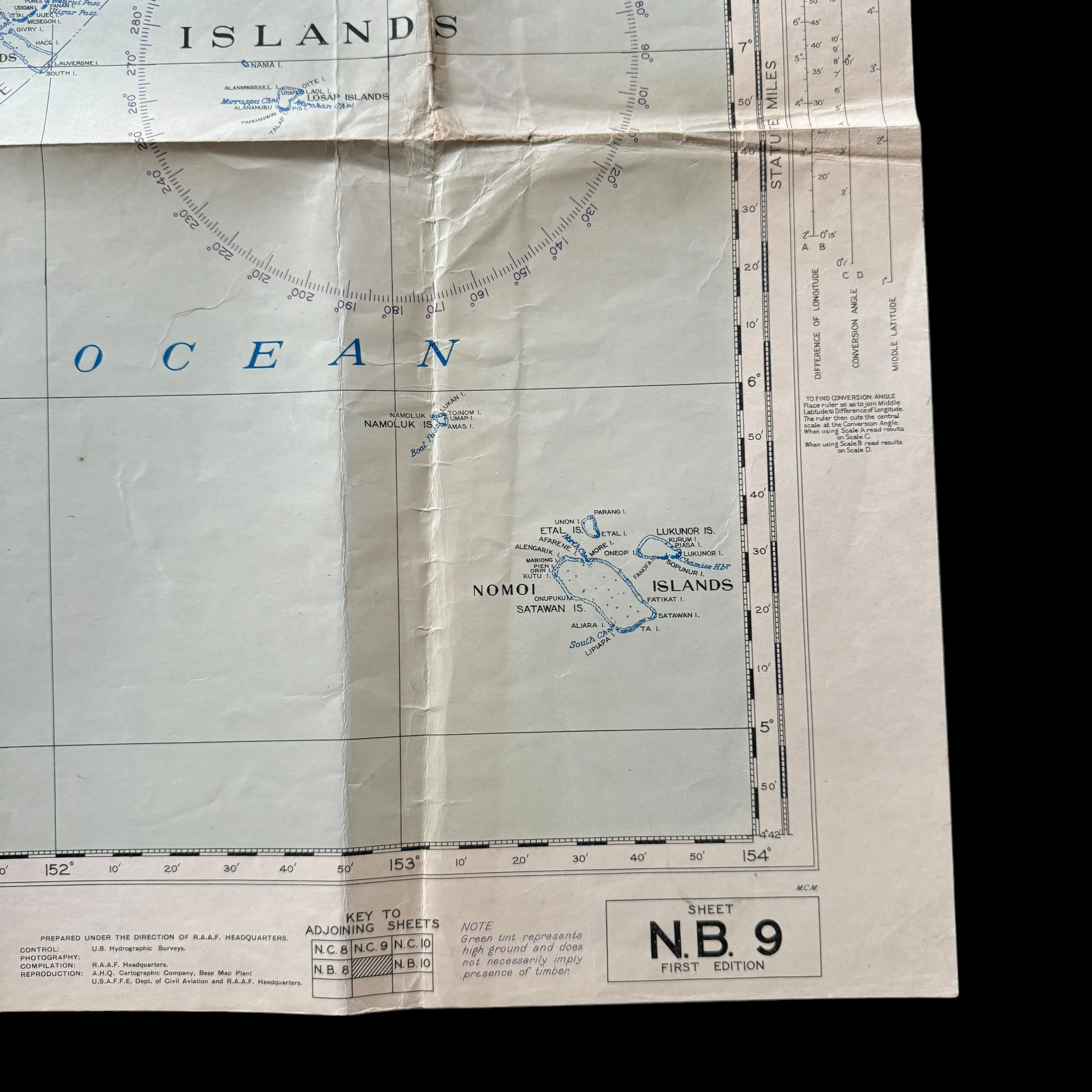
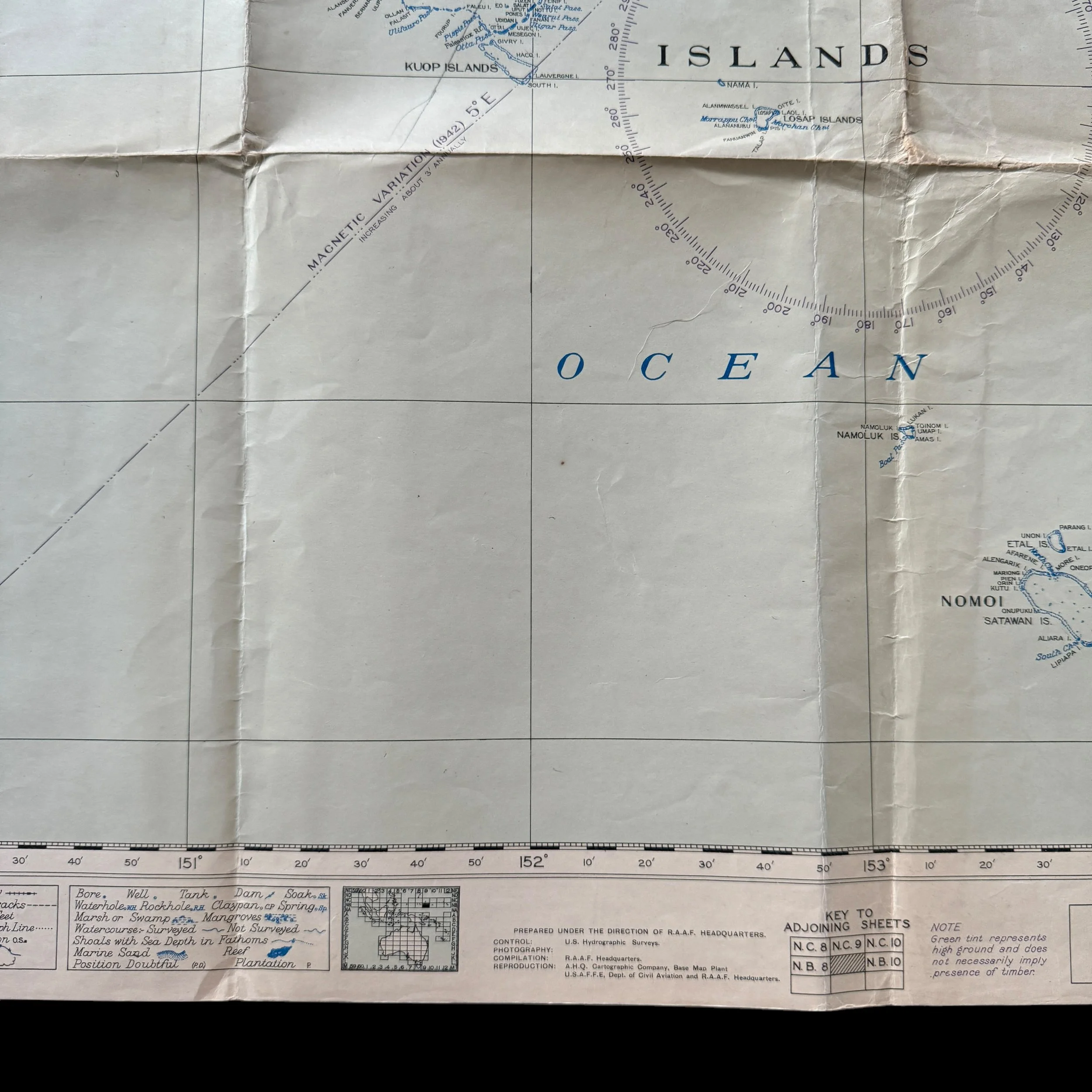

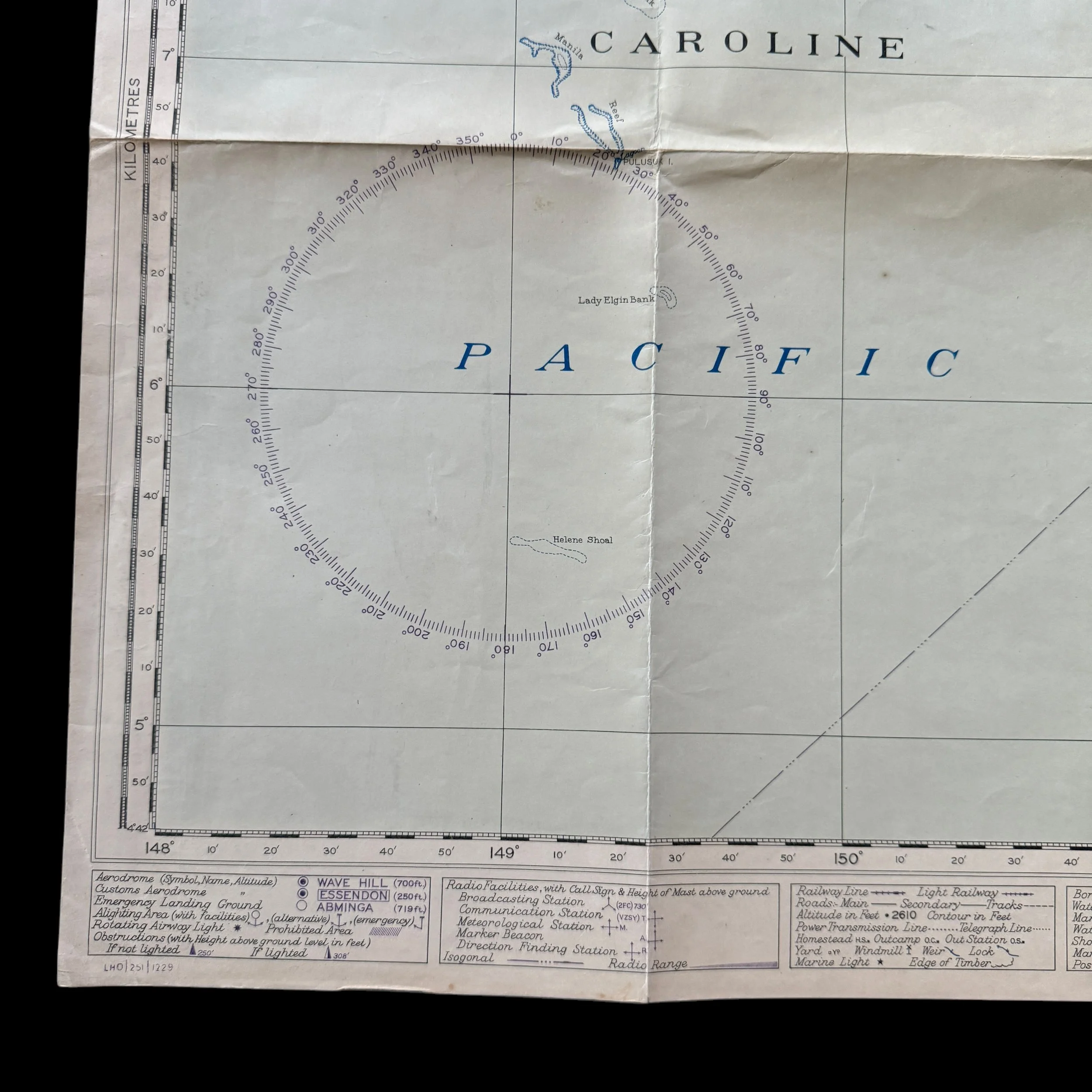
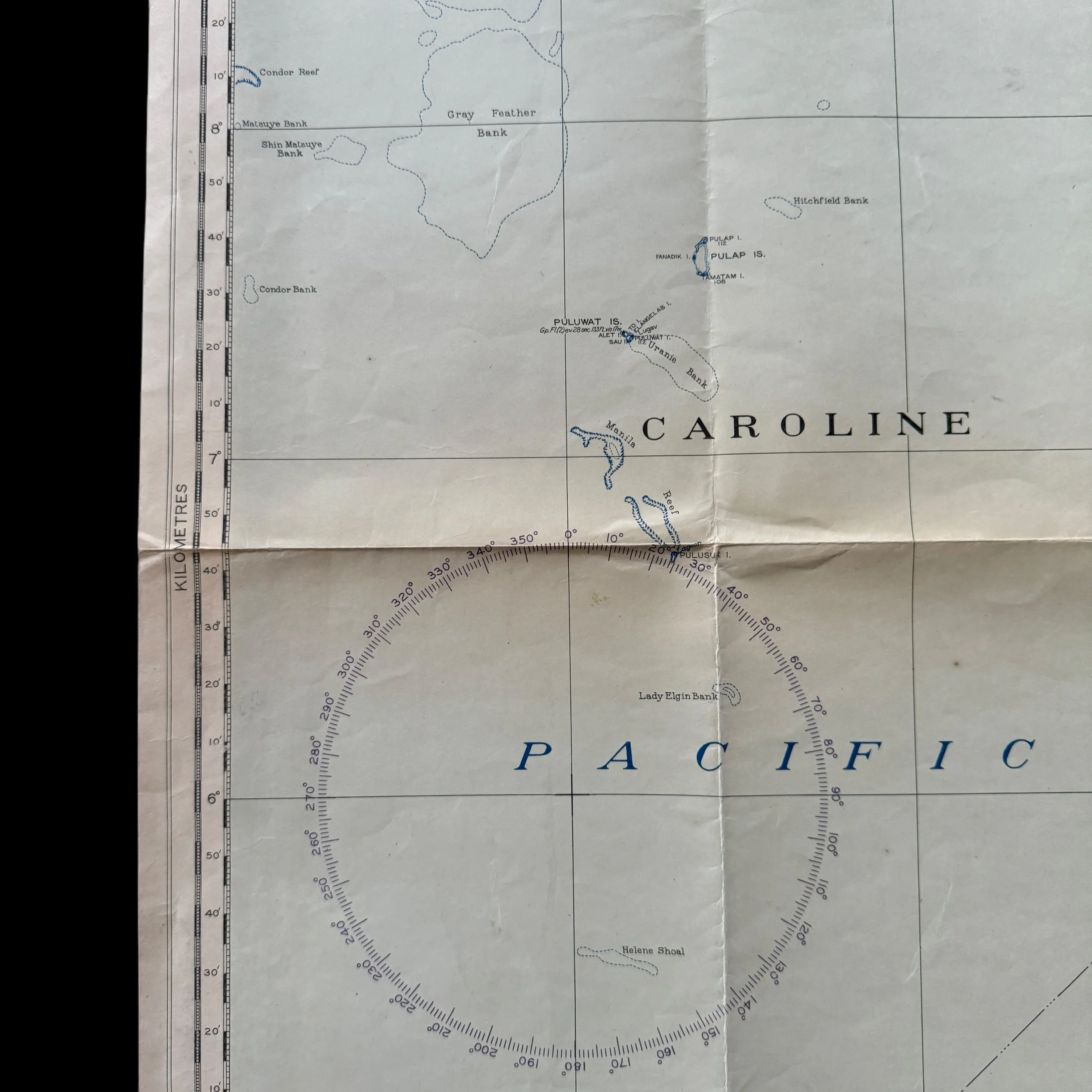

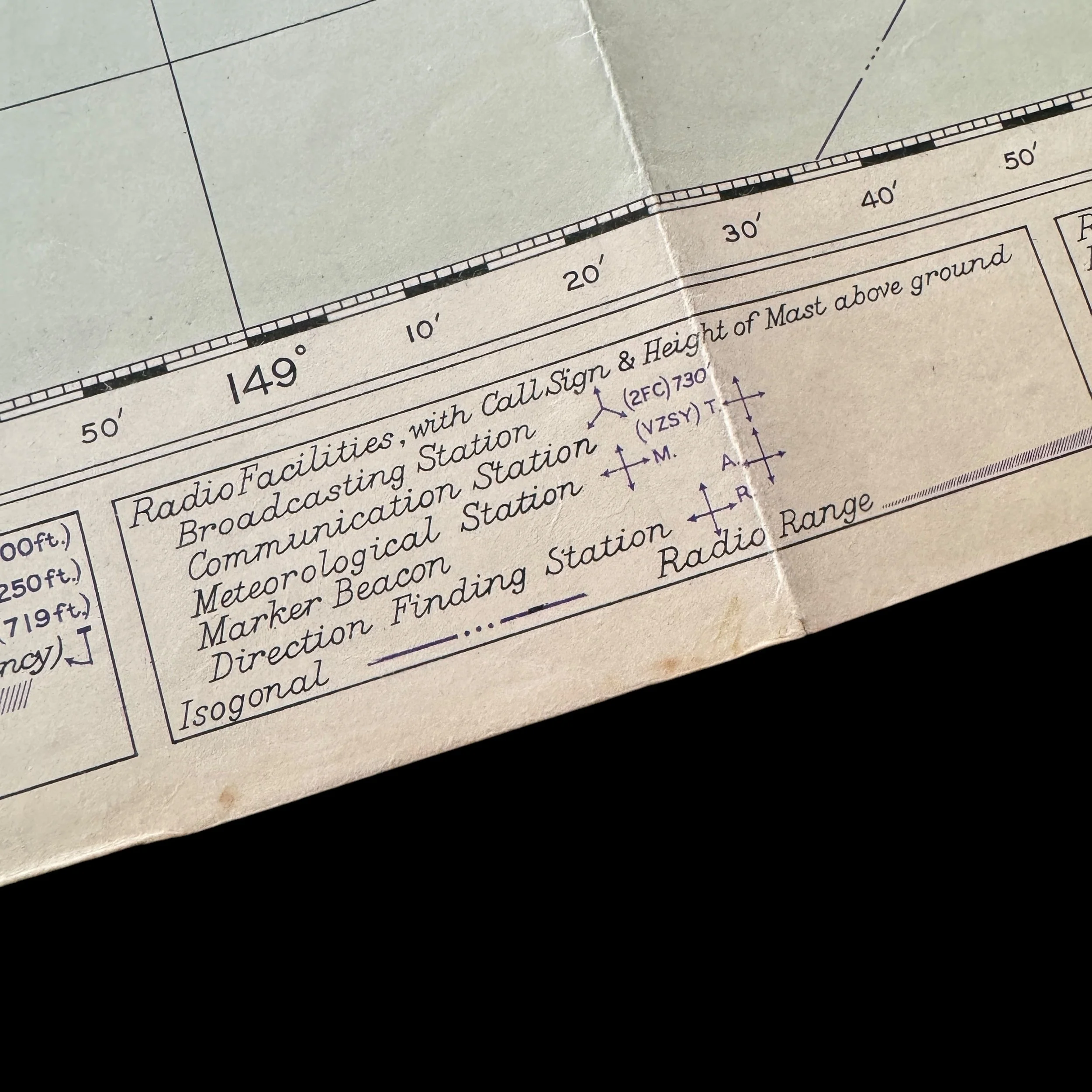
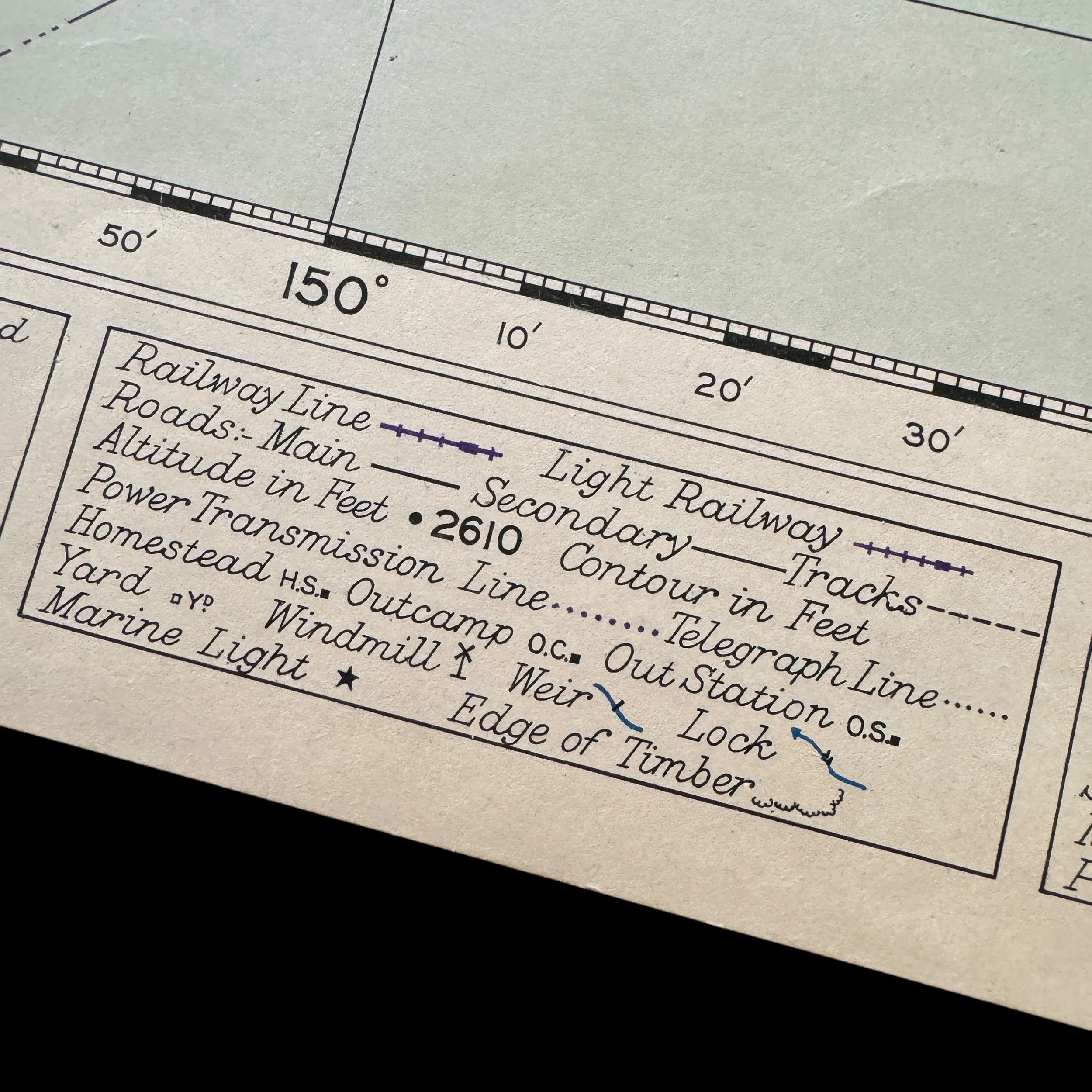
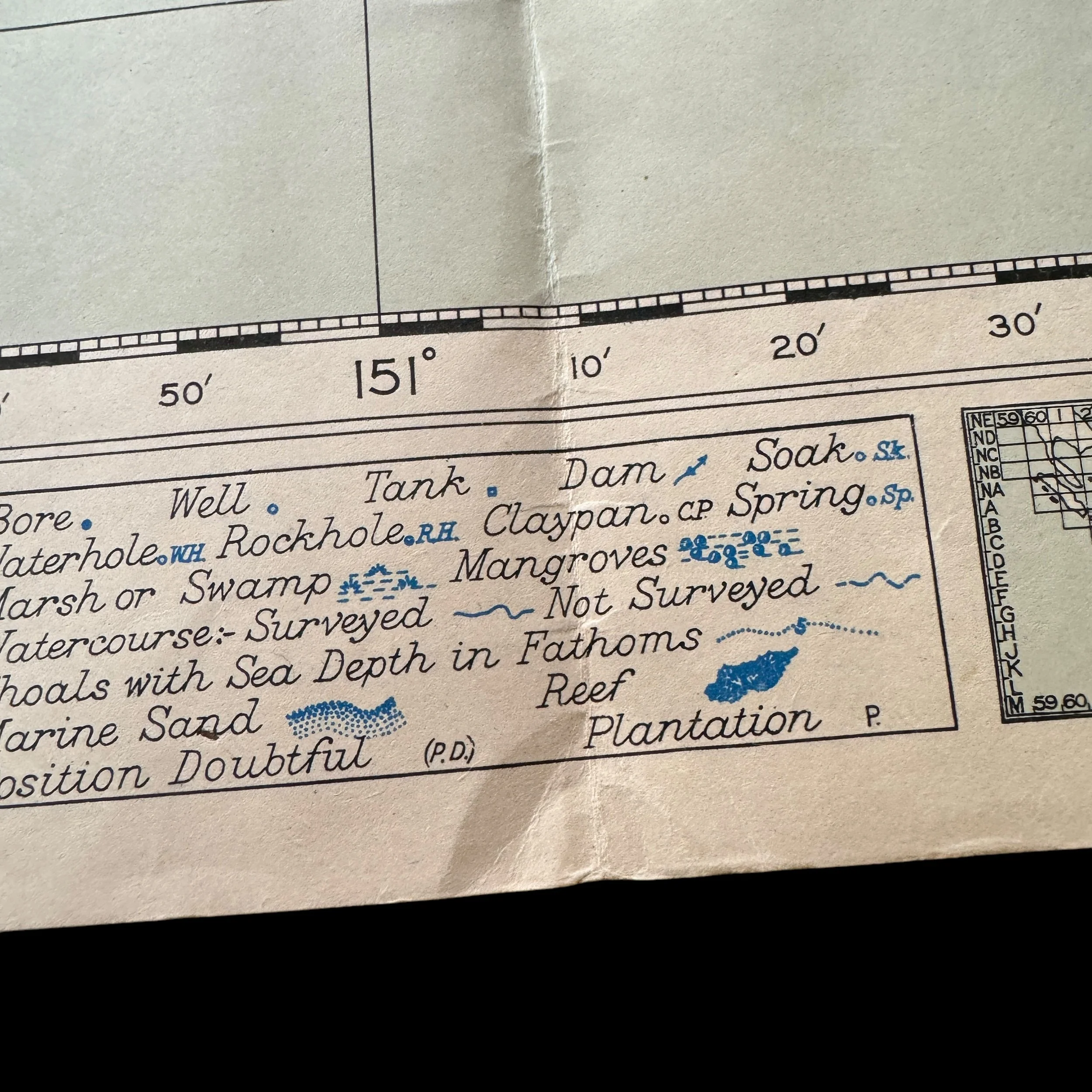
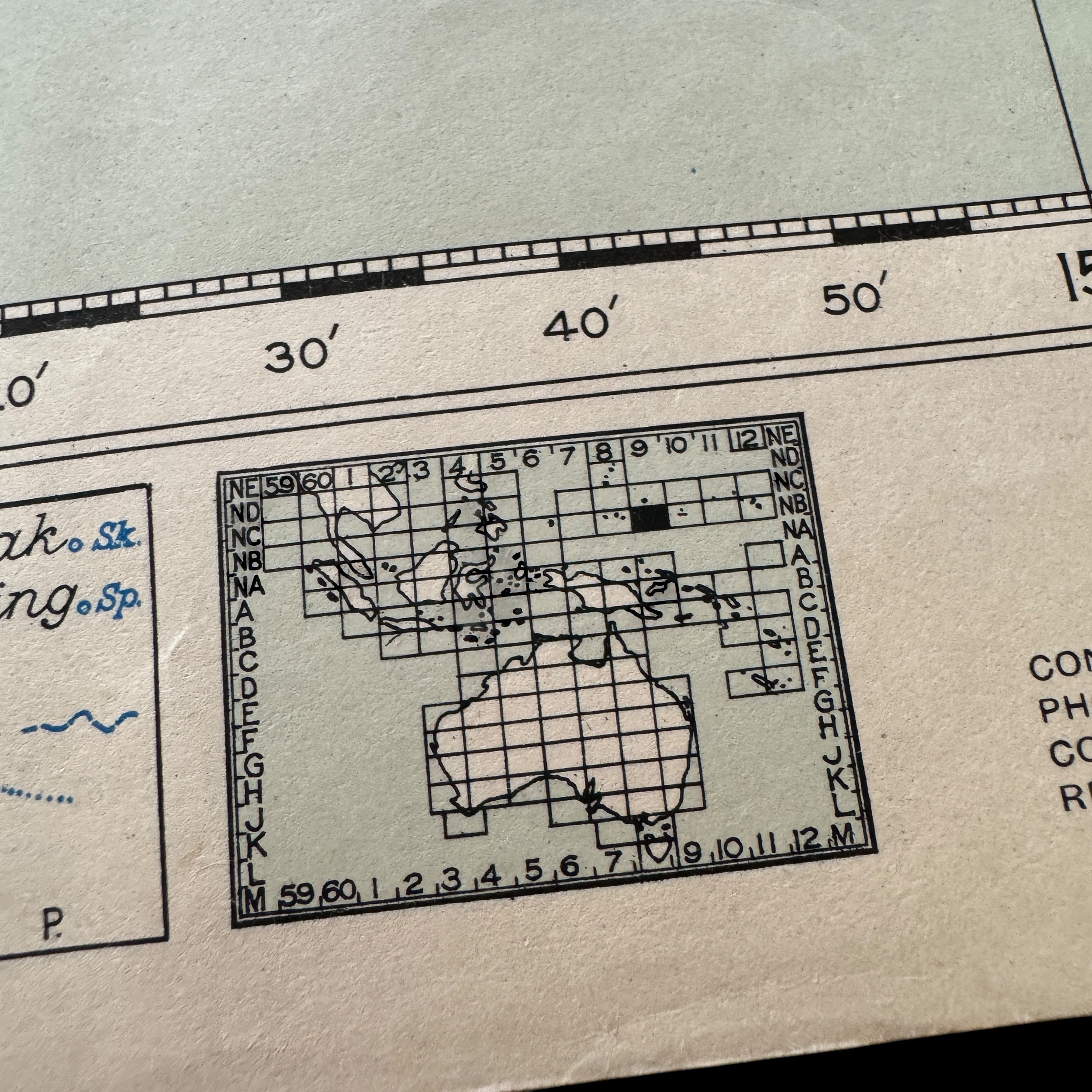
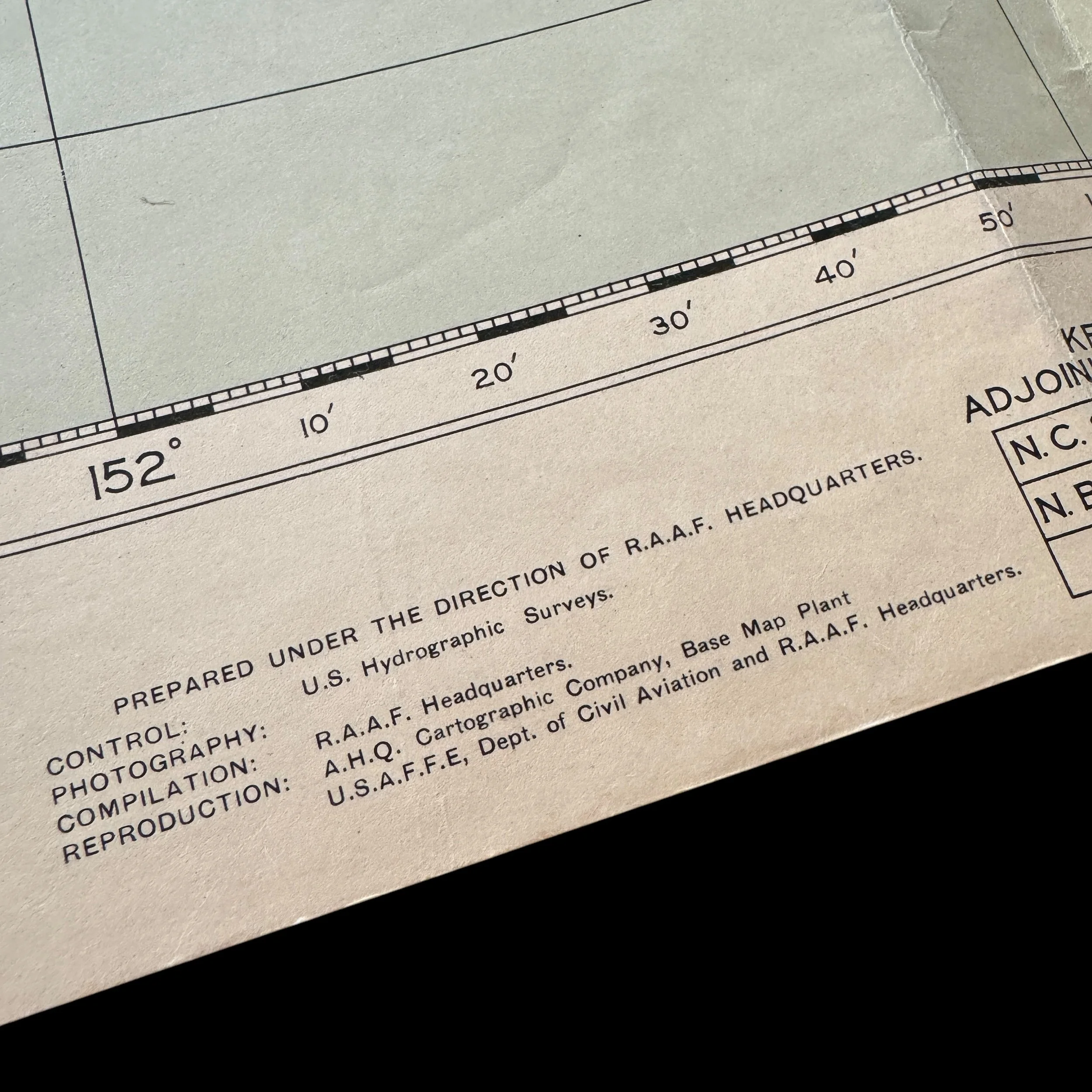
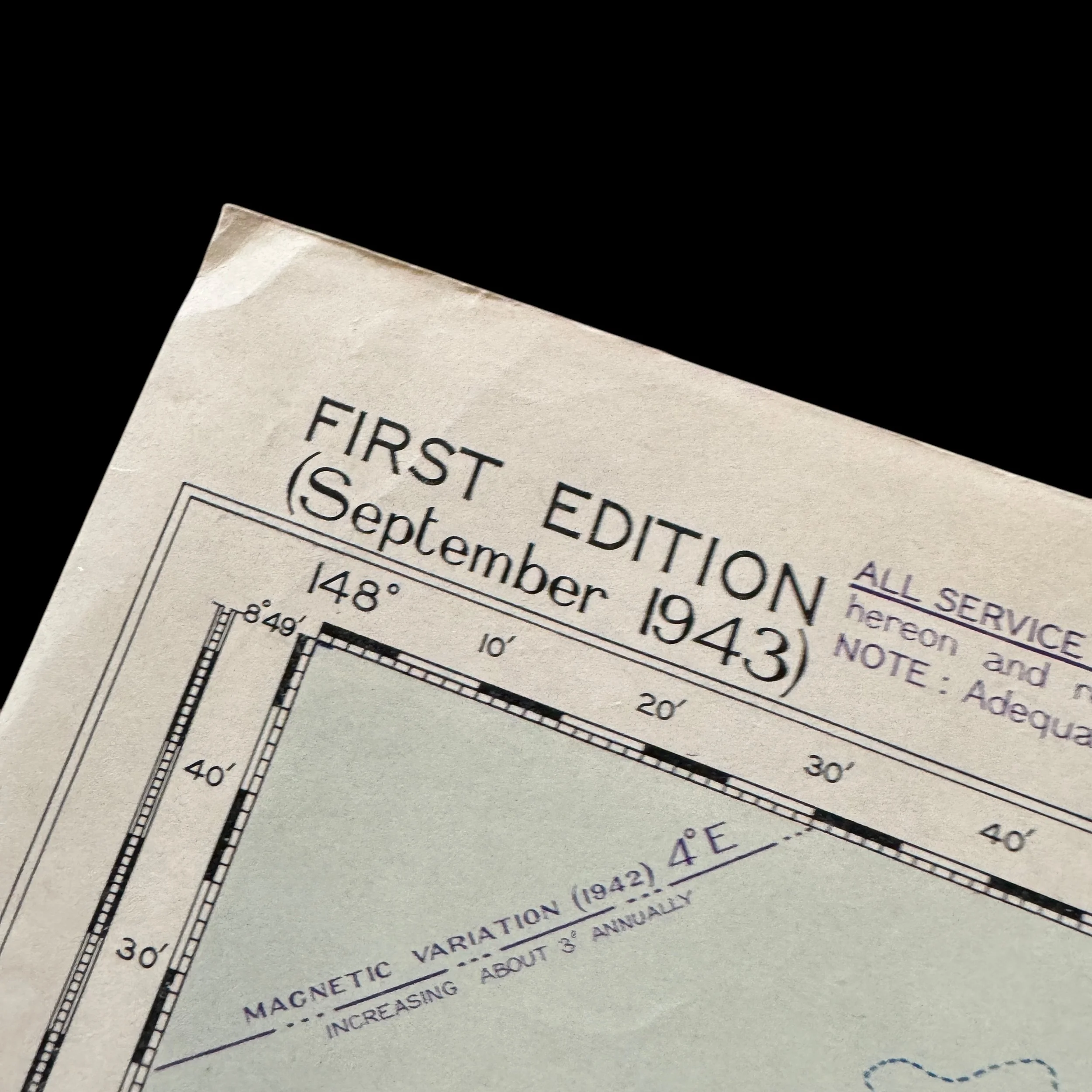
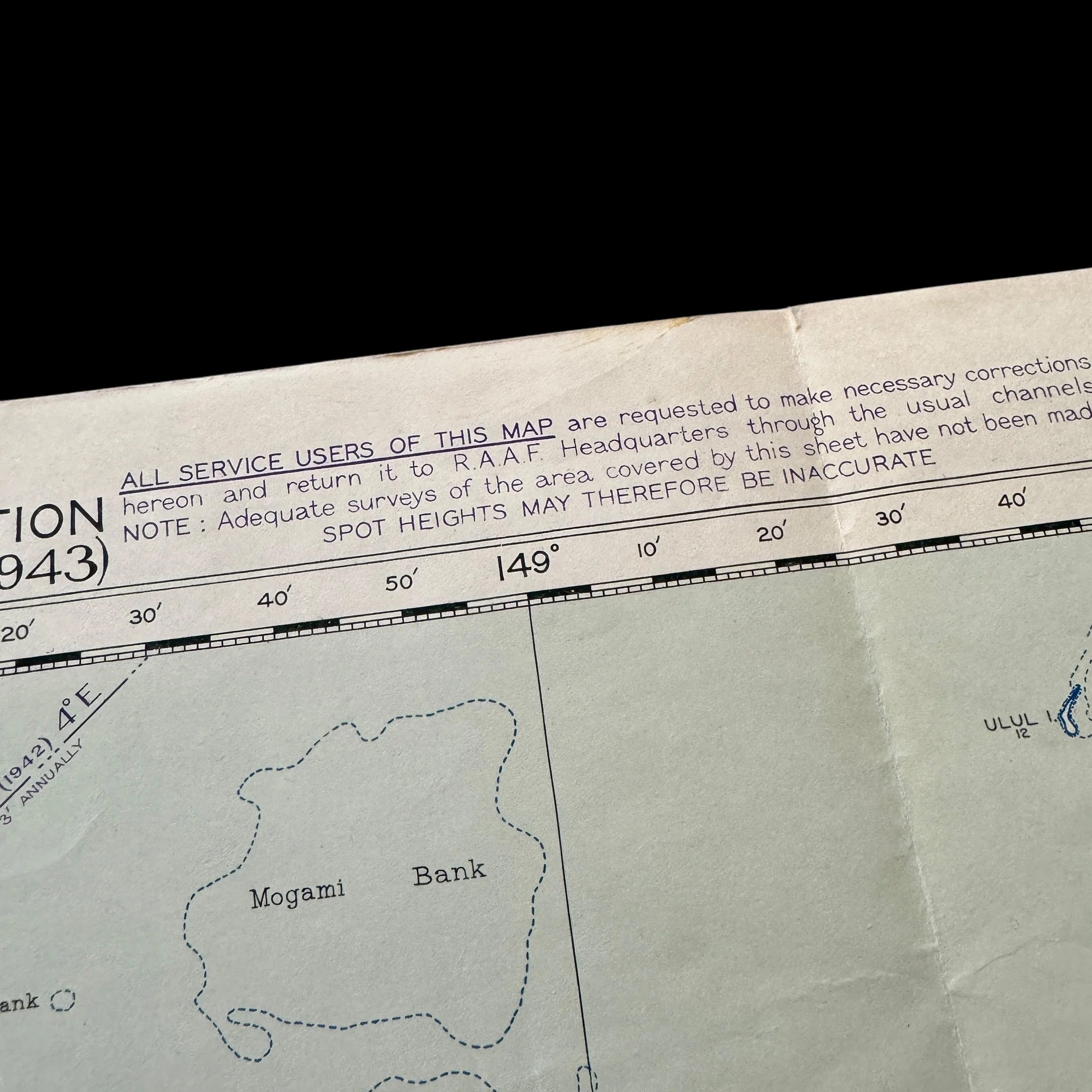
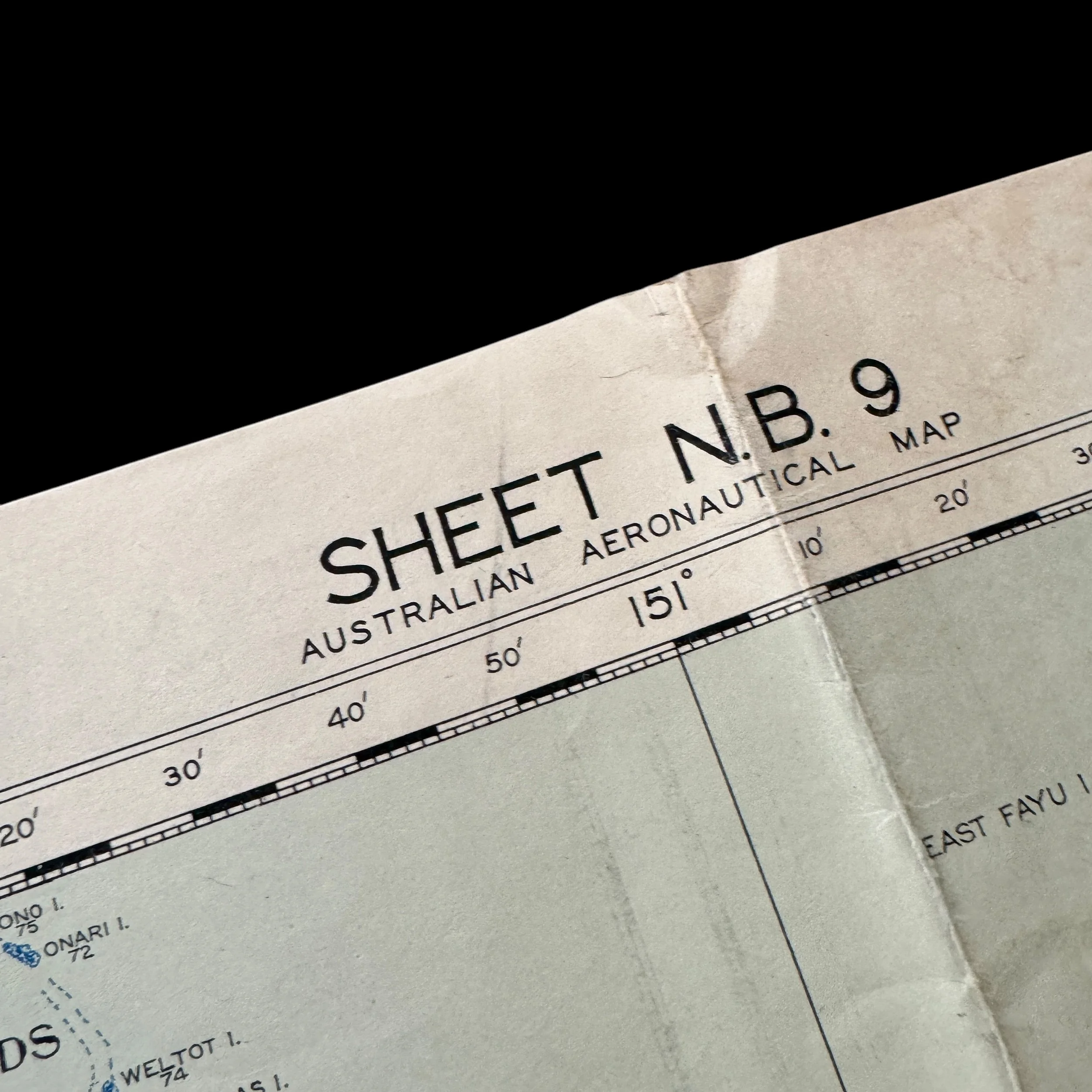
RARE! WWII 1943 U.S. 5th Air Force Caroline Islands "South West Pacific Area Command" Combat Flight Navigation Map
Comes with hand-signed C.O.A. and a full historical write-up
Type: Original World War II U.S. Army Air Force Combat Flight Navigation Map Specially Prepared for the U.S. 5th Air Force by South West Pacific Area Command.
Campaign/Operations: Pacific Theater - Caroline Islands - Truk Islands - Nomoi Island -Hall Islands
This exceptionally rare, museum-grade World War II combat flight navigation map, dated September 1943, was produced under Land Headquarters – South West Pacific Area Command and used by the U.S. Fifth Air Force in critical aerial operations over the Caroline Islands, including Truk, Nomoi, and Hall Islands. As a key player in the Pacific Theater from 1943 to 1945, the Fifth Air Force, under General George C. Kenney, launched coordinated bombing campaigns to cripple Japanese air and naval power, particularly targeting Truk, Japan’s central stronghold in the Pacific. Guided by maps like this, aircraft such as the B-24 Liberator, B-25 Mitchell, and A-20 Havoc carried out precision strikes on airfields, supply depots, and naval installations, while P-38 Lightning fighters ensured air superiority. These efforts culminated in Operation Hailstone in February 1944, a devastating aerial assault that neutralized Truk as a strategic base and paved the way for the Allied advance. This artifact serves as a tangible link to the relentless air battles that shaped the Pacific War, embodying the ingenuity, coordination, and determination of the U.S. Fifth Air Force in one of the most decisive aerial campaigns of World War II.
Date: September 1943
Size: 21.5 × 30 inches
This exceptionally rare, museum-grade World War II artifact is an original combat flight navigation map, dated September 1943, produced under Land Headquarters – South West Pacific Area Command. Developed through the strategic collaboration between the U.S. Fifth Air Force and the Royal Australian Air Force (RAAF), this map played a pivotal role in navigating aerial missions over the Caroline Islands, including Truk Islands, Nomoi Island, and Hall Islands—key targets in the Allied campaign to neutralize Japan’s air and naval supremacy in the Pacific.
From 1943 to 1945, the U.S. Fifth Air Force, under General George C. Kenney, was instrumental in executing highly coordinated air strikes in the Central and South Pacific, particularly against heavily fortified Japanese positions in the Caroline Islands. These islands—especially Truk, often referred to as the "Gibraltar of the Pacific"—were a major hub for Japanese air and naval operations. Truk’s extensive airfields, repair docks, and anchorages served as the primary logistical base for Japan’s operations throughout the Pacific. Using maps like this one, the Fifth Air Force orchestrated relentless bombing campaigns designed to cripple Japanese aviation, supply lines, and fleet movements. Working in tandem with reconnaissance flights and intelligence gathered from Australian forces, these missions paved the way for Operation Hailstone in February 1944, a devastating two-day aerial assault on Truk that destroyed over 200 Japanese aircraft and dozens of warships. This battle was a turning point, effectively neutralizing Truk as an operational base and ensuring Allied air superiority over the central Pacific.
The Fifth Air Force deployed a range of aircraft in the Caroline Islands campaign, each tailored for precision bombing, aerial combat, and close air support. The B-24 Liberator, with its high-altitude, long-range capabilities, was essential in hitting enemy fortifications deep within the Caroline Islands, including airfields and naval facilities at Truk and Nomoi. The B-25 Mitchell, a versatile medium bomber, was particularly effective in low-level strafing runs and skip-bombing Japanese convoys around Hall Islands. For tactical strikes on supply depots and enemy defenses, the A-20 Havoc delivered low-altitude attacks, proving highly effective against Japanese strongholds. Meanwhile, the P-38 Lightning played a crucial role in achieving air superiority, engaging Japanese Zero fighters in dogfights over Truk and providing essential escort protection for bomber formations. These aircraft, guided by maps like this one, delivered continuous strikes on key Japanese positions, cutting off reinforcements and reducing the enemy’s ability to mount counterattacks.
This combat navigation map was actively used by U.S. bomber crews and reconnaissance pilots as they executed missions targeting enemy-controlled airstrips, refueling stations, and communication hubs across the Caroline Islands. The precise mapping of atolls, airfields, and enemy positions allowed for the calculated coordination of bombing raids, ensuring maximum effectiveness while minimizing risks to Allied forces. By 1945, the relentless air campaign had severely crippled Japanese defensive capabilities, setting the stage for the U.S. invasion of the Philippines and the final push toward Japan. The destruction of Truk as a functioning air base—aided by the detailed navigation provided by maps like this—marked a decisive shift in the Pacific War.
This World War II combat navigation map is more than just a relic—it is a tangible piece of history that reflects the determination, tactical ingenuity, and relentless air superiority of the U.S. Fifth Air Force in one of the most critical campaigns of the Pacific Theater. Used in highly classified bombing missions, this artifact embodies the strategic brilliance of Allied aerial warfare, offering a rare and museum-quality connection to the airmen who helped turn the tide of war in the Pacific.
Condensed 1944-1945 History of U.S. Fifth Air Force in the Pacific Theater:
The U.S. Fifth Air Force served as the aerial spearhead of General Douglas MacArthur’s island-hopping campaign from 1944 to 1945, playing a critical role in securing air superiority, conducting strategic bombing, and providing close air support for ground forces across the Pacific. As MacArthur’s forces advanced toward the Philippines and ultimately Japan, the Fifth Air Force was responsible for neutralizing key Japanese strongholds, disrupting enemy supply lines, and ensuring the success of amphibious landings. Throughout 1944, the Fifth Air Force was heavily engaged in the New Guinea Campaign, supporting operations in Hollandia (April 1944), Biak (May–June 1944), Noemfoor (July 1944), and Morotai (September 1944). These battles secured critical airfields, allowing the Allies to extend their operational reach further into the Pacific. The Admiralty Islands campaign (February–May 1944)was another key operation, during which the Fifth Air Force conducted extensive bombing raids and fighter sweeps to eliminate Japanese resistance on Los Negros and Manus Island. These islands provided the Allies with forward bases to launch further operations against the Philippines. By late 1944, the Fifth Air Force was instrumental in the Philippines Campaign, beginning with the Battle of Leyte Gulf (October 1944), where it conducted bombing raids on enemy airfields and provided air cover for naval and ground forces. As the campaign progressed into Luzon (January 1945), Mindoro, and Mindanao, Fifth Air Force aircraft engaged in relentless airstrikes against Japanese defensive positions, shipping convoys, and troop concentrations. Throughout these operations, the Fifth Air Force employed a variety of aircraft, including P-38 Lightnings, B-24 Liberators, B-25 Mitchells, and A-20 Havocs, to strike Japanese airfields, infrastructure, and reinforcements across islands such as Palawan, Cebu, Panay, and Borneo. As the war neared its end in mid-1945, the Fifth Air Force continued its air campaigns against Formosa (Taiwan) and the Ryukyu Islands, ensuring that Japan’s ability to counter the Allied advance was further diminished. By securing these islands, the Fifth Air Force played a decisive role in paving the way for the final stages of the Pacific War, culminating in the liberation of the Philippines and the eventual planning for an invasion of Japan.
19th Bombardment Group
22nd Bombardment Group
2d Combat Cargo Group
312th Bombardment Group
317th Troop Carrier Group
345th Bombardment Group
348th Fighter Group
35th Fighter Group
374th Troop Carrier Group
375th Troop Carrier Group
380th Bombardment Group
38th Bombardment Group
3rd Air Commando Group
3rd Bombardment Group
417th Bombardment Group
433rd Troop Carrier Group
43rd Bombardment Group
475th Fighter Group
49th Fighter Group
54th Troop Carrier Wing
58th Fighter Group
6th Reconnaissance Group
71st Reconnaissance Group
85th Fighter Wing
86th Fighter Wing
8th Fighter Group
90th Bombardment Group
91st Reconnaissance Wing
V Bomber Command
V Fighter Command